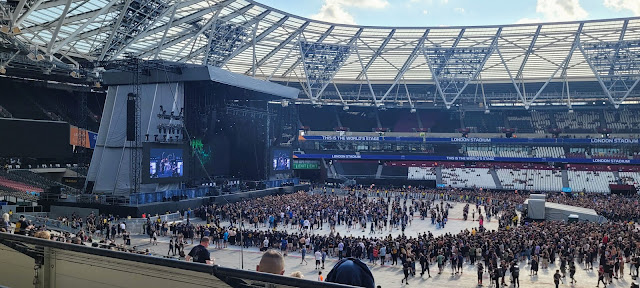Saturday June 28, 2025.
I have been following 'Iron Maiden' since I was 10 years old, with their single, 'Run to the Hills', being the first 7" that I purchased.
After seeing them live on countless occasions, meeting some of the band members and visiting the 'Cart & Horses', where they first played live, I was excited to see them at the London Stadium, during their 50th year.
My friend of almost 35 years, David, had secured the tickets.
Keilyn and I travelled to Canning Town, where we checked into our hotel, with Emma and Erin, who, while we were at the concert, would visit the shopping centre in Stratford. We then travelled to Stratford together, before Keilyn and I headed off towards the Olympic Park, where we waited in the shade of the Sadler's Wells Theatre for David and his son Antonio.
Soon enough we spotted them and, after the usual greetings, joined the massed groups of fans headed towards the London Stadium. We crossed Bridge 5 and passed through security, bought a souvenir Matchday Programme and waited in the shade for the gates to open.
At exactly 17:00 the gates opened and we moved inside the stadium, making our way to the Merchandise stall. A T-shirt for Antonio, a Baseball cap for David, a studded leather wristband for Keilyn and a scarf for myself. We then purchased some drinks and went looking for our seats, which were on tier 2 in the 'Billy Bonds Stand' (East Stand).
The weather was clear skies, with the the occasional cloud, and not a breath of wind, with the temperature at 29°C. As we were in the East Stand, the sun was beating down on us, so we headed back downstairs and waited in the shade.
We took our seats, just before 17:45, so that we could watch 'The Raven Age' open the concert. They began with 'Forgive & Forget', before rattling through seven tracks, finishing with 'Fleur De Lis'.
As soon as their set, which was an incredible 45 minutes of pure rock, finished, we headed back down into the cool shade of the stadium. Snacks, food and more drinks were purchased.
We made our way back up to our seats in time to watch Halestorm take to the stage, at 19:00. 'Fallen Star' began a 10-track set, where Lzzy Hale's impressive vocal range was on full display, while Arejay Hale's drum solo was out of this world! Throughout the 50-minute set the sun had continued to beat down, but, thankfully, was gradually getting lower in the sky.
Back outside into the shade for more fluids, while the stage was prepared for the main event: The Homecoming of Steve Harris... and 'Iron Maiden'.































